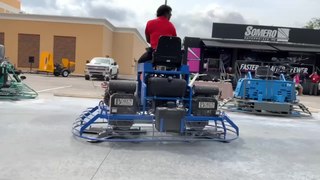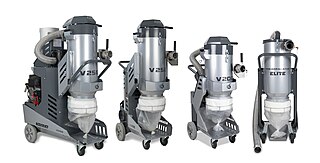Gallery
- Smoothing concrete with a large concrete float, or bull float
- Hand float for concrete (upside down)
A concrete float is a tool used to finish a concrete surface by making it smooth. A float is used after the surface has been made level using a screed. In addition to removing surface imperfections, floating will compact the concrete as preparation for further steps.
A float can be a small hand tool, a larger bull float with a long handle, or a power trowel (also called a power float) with an engine. Concrete floats are generally made of magnesium, aluminum, or wood.

A chisel is a wedged hand tool with a characteristically shaped cutting edge on the end of its blade, for carving or cutting a hard material. The tool can be used by hand, struck with a mallet, or applied with mechanical power. The handle and blade of some types of chisel are made of metal or wood with a sharp edge in it.
Float may refer to:

Beveled glass is usually made by taking thick glass and creating an angled surface cut (bevel) around the entire periphery. Bevels act as prisms in sunlight creating an interesting color refraction which both highlights the glass work and provides a spectrum of colors which would ordinarily be absent in clear float glass.

Grout is a dense substance that flows like a liquid yet hardens upon application, and it gets used to fill gaps or to function as reinforcement in existing structures. Grout is generally a mixture of water, cement, and sand, and it frequently gets employed in efforts such as pressure grouting, embedding rebar in masonry walls, connecting sections of precast concrete, filling voids, and sealing joints such as those between tiles. Common uses for grout in the household include filling in tiles of shower floors and kitchen tiles. It is often color tinted when it has to be kept visible and sometimes includes fine gravel when being used to fill large spaces. Unlike other structural pastes such as plaster or joint compound, correctly mixed and applied grout forms a water-resistant seal.

A hand plane is a tool for shaping wood using muscle power to force the cutting blade over the wood surface. Some rotary power planers are motorized power tools used for the same types of larger tasks, but are unsuitable for fine-scale planing, where a miniature hand plane is used.

A file is a tool used to remove fine amounts of material from a workpiece. It is common in woodworking, metalworking, and other similar trade and hobby tasks. Most are hand tools, made of a case hardened steel bar of rectangular, square, triangular, or round cross-section, with one or more surfaces cut with sharp, generally parallel teeth. A narrow, pointed tang is common at one end, to which a handle may be fitted.

A trowel is a small hand tool used for digging, applying, smoothing, or moving small amounts of viscous or particulate material. Common varieties include the masonry trowel, garden trowel, and float trowel.

A rake is a broom for outside use; a horticultural implement consisting of a toothed bar fixed transversely to a handle, or tines fixed to a handle, and used to collect leaves, hay, grass, etc., and in gardening, for loosening the soil, light weeding and levelling, removing dead grass from lawns, and generally for purposes performed in agriculture by the harrow.

A sander is a power tool used to smooth surfaces by abrasion with sandpaper. Sanders have a means to attach the sandpaper and a mechanism to move it rapidly contained within a housing with means to handhold it or fix it to a workbench. Woodworking sanders are usually powered electrically, and those used in auto-body repair work are usually powered by compressed air. There are many different types of sanders for different purposes. Multipurpose power tools and electric drills may have sander attachments.
Metalworking hand tools are hand tools used in the metalworking field, powered entirely by the operator. There are lots of tools, fit for different actions to the material, such as shrinking or modifying its surface.

Plasterwork is construction or ornamentation done with plaster, such as a layer of plaster on an interior or exterior wall structure, or plaster decorative moldings on ceilings or walls. This is also sometimes called pargeting. The process of creating plasterwork, called plastering or rendering, has been used in building construction for centuries. For the art history of three-dimensional plaster, see stucco.

A plasterer is a tradesman who works with plaster, such as forming a layer of plaster on an interior wall or plaster decorative moldings on ceilings or walls. The process of creating plasterwork, called plastering, has been used in building construction for centuries. A plasterer is someone who does a full 4 or 2 years apprenticeship to be fully qualified.

A concrete finisher is a skilled tradesperson who works with concrete by placing, finishing, protecting and repairing concrete in engineering and construction projects. Concrete finishers are often responsible for setting the concrete forms, ensuring they have the correct depth and pitch.
This glossary of woodworking lists a number of specialized terms and concepts used in woodworking, carpentry, and related disciplines.

Tuckpointing is a way of using two contrasting colours of mortar in the mortar joints of brickwork, with one colour matching the bricks themselves to give an artificial impression that very fine joints have been made. In some parts of the United States and Canada, some confusion may result as the term is often used interchangeably with pointing and repointing.

The masonry trowel is a hand trowel used in brickwork or stonework for levelling, spreading and shaping mortar or concrete. They come in several shapes and sizes depending on the task. The following is a list of the more common masonry trowels:

Screed has three meanings in building construction:

A power concrete screed is a tool used to smooth and level freshly poured concrete surfaces. It can be used in place of a man-powered screed bar to strike off excess concrete. A power screed works by consolidating and/or vibrating the wet concrete mixture. The screed moves back and forth, as friction screeds or "roller" screeds level the concrete, filling holes and lowering any high spots. Power screeds can be powered by gas, electricity or hydraulics.

A power trowel is a piece of light construction equipment used by construction companies and contractors to apply a smooth finish to concrete slabs.

A concrete grinder is an abrasive machine for grinding and polishing concrete and natural stone. Concrete grinders can come in many configurations, the most common being a hand-held general purpose angle grinder, but it may be a specialized tool for countertops or floors. Angle grinders are small and mobile, and allow one to work on harder to reach areas and perform more precise work.